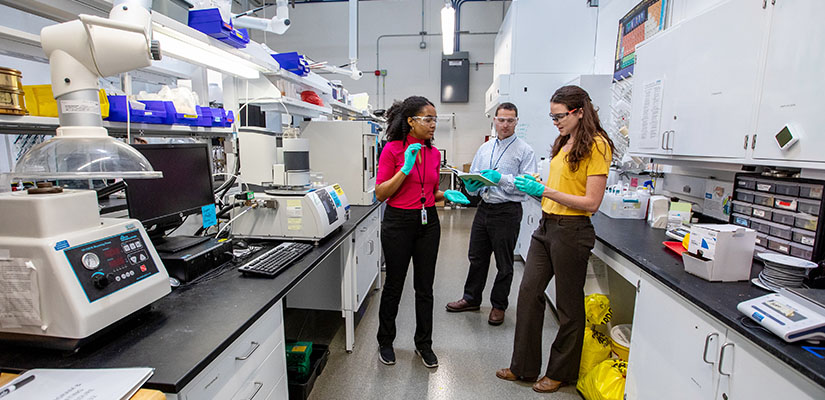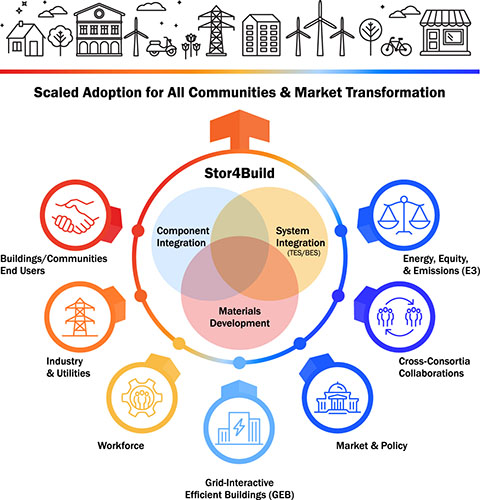Exploring Thermal Energy Storage Solutions for Energy-Efficient Buildings
Can Cooling Methods of the 1800s Advance Energy Storage Needs for a Clean Energy Future?

Picture yourself 200 years ago, only able to cool a space or chill perishable food because ice blocks were cut from frozen lakes and then transported cross-country by insulated rail cars to your home. Once in your home, the ice melted—by absorbing heat to change the phase from solid to liquid—keeping your home or food cool. Water, when frozen, stores this ability to cool because of the large amount of energy absorbed (when melting) or to heat by releasing energy (when freezing).
Technologies to heat and cool buildings have dramatically improved, so why are scientists revisiting these phase-change processes tracing back to the 1800s? Some say it could be the golden ticket to a clean energy future.
Established in November 2022, Stor4Build is a multilaboratory consortium working to accelerate the development, optimization, and equitable deployment of cost-effective thermal energy storage (TES) technologies to enable buildings to efficiently run on renewable energy sources.
"The science behind TES can be as simple as what people did 200 years ago," said Tim LaClair, a senior researcher at the National Renewable Energy Laboratory (NREL). "However, today, we are exploring various materials, controls, standards, building integration, and much more to allow the systems to be affordable and ensure occupant comfort. This research is a vital pathway to the electrification and decarbonization of our buildings."
Buildings are a big obstacle to achieving equitable decarbonization goals nationwide—as much as 50% of electricity consumption in U.S. buildings goes toward meeting heating and cooling demands. Aligning this electricity consumption with renewable energy generation is a main focus for Stor4Build.
The consortium is investigating novel TES materials and systems, which can adjust when heating or cooling is created, stored, and delivered. Leveraging collaborative TES research will help level out peak energy demand, reduce potential grid outages, and enable more cost-effective electrification of buildings. TES shows promise in making the process of heating and cooling buildings more manageable, less expensive, more efficient, and better prepared to flexibly manage power from renewable energy sources to deliver when energy is needed the most.
What Is Thermal Energy Storage?
TES systems can be installed in buildings in a way that allows the building to act as a thermal battery. Energy, potentially from renewable sources such as solar or wind, is stored in tanks or other vessels filled with materials—such as ice, wax, salt, or sand—for use at a different time.
Som Shrestha, a senior R&D scientist within the Building Technologies Research and Integration Center at Oak Ridge National Laboratory (ORNL), said TES can significantly reduce peak heating, ventilating, and air conditioning energy demand in buildings.
"The time of available useful thermal energy and when the building needs it typically do not coincide. Therefore, TES systems are needed to store useful thermal energy when available and use it to offset heating and cooling demand when needed," Shrestha said.
Shrestha also explained how ORNL developed a "thermally anisotropic building envelope," which can harvest thermal energy from the exterior envelope and store it in TES for later use.
Research Is Heating Up
"Even though the idea of TES has been around for a long time, this is all new research," LaClair said. "Stor4Build is a concerted effort to ramp up efforts across national labs, as well as partners across industry, academia, communities, and more. We need to develop the system of integrated technology and enable market adoption, not just the material itself."

LaClair said a large component of TES advancement depends on identifying and developing needed phase-change materials with a melting and freezing point close to room temperature. This means the material will freeze when the home is slightly cooler than the material's melting point, releasing energy and heating the home, and will melt when the home is slightly warmer, absorbing energy and cooling the home. This provides more comfortable indoor spaces that use less electricity for heating and cooling.
"If a family wants to heat their home to 70˚F, for example, the TES system requires a material that melts and freezes within that range of temperature," LaClair added. "Various waxes naturally have that melting point but are more expensive. The goal is to develop and optimize very low-cost storage materials, such as salt hydrates or thermochemical materials."
New research out of Lawrence Berkeley National Laboratory (Berkeley Lab) includes a project to develop thermochemical material-based TES. These materials can theoretically store more thermal energy than phase-change materials by charging with solar energy or excess grid electricity, and then discharging to supply thermal space and water heating in buildings.
"New advanced thermal energy storage systems, which are based on abundant and cost-effective raw materials, can meet the demand for thermal loads across time lengths similar to electrochemical storage devices," said Sumanjeet Kaur, Berkeley Lab's Thermal Energy Group lead. "This will not only relax some of the demand for electrochemical storage and free up batteries but also increase versatility and efficiency of energy storage systems in buildings."
LaClair added that one aspect of the consortium's work will continue the development of new materials to integrate into the project or create the infrastructure to use current materials for the demonstration.
Researchers at NREL and ORNL are exploring hybrid designs, artificial intelligence, and machine learning to develop a framework to study the bigger picture. Simulation models and tools can assess the energy cost savings, peak load reduction, and needed life cycle updates, and then advise how to further drive down TES costs in real time. These advancements can aid in enhancing the effectiveness and affordability of TES and conversion systems and overcoming the obstacles preventing their mainstream adoption.
More About Stor4Build
Stor4Build includes active participants from industry, utilities, nonprofit organizations, communities, building owners, academia, government, and other research institutions.

"Thermal energy research is necessary for the large-scale deployment of renewable energy, electrification, and building decarbonization," said Judith Vidal, NREL Building Thermal Energy Science group manager and Stor4Build co-director. "We need to combine forces and expertise to advance TES solutions from lab to market to all communities."
Work across the consortium is categorized into four research areas: materials optimization and manufacturing; modeling and analysis; system optimization and integration; and market, policy, and equity. Two steering councils (research and development and market adoption) support equity-centric scaled adoption of building energy storage technologies and market transformation to increase market viability.
As part of its five-year plan, Stor4Build aims to develop, evaluate, and launch a community-scale demonstration of aggregated peak load shifting of 50–100 kW, while reducing the power consumption for thermal loads of individual homes by at least 50%, for a duration of 4–6 hours.
Funded by the Department of Energy Building Technologies Office, Stor4Build is co-led by NREL, Berkeley Lab, and ORNL.
Contact Stor4Build for more information on ways to collaborate or to receive the latest consortium updates.

